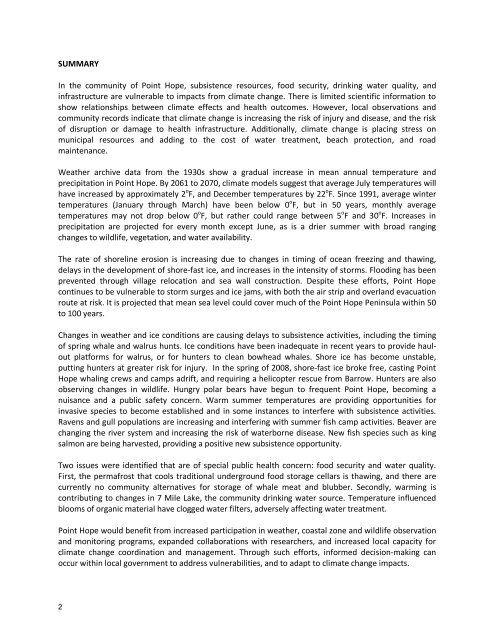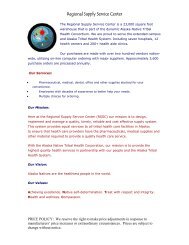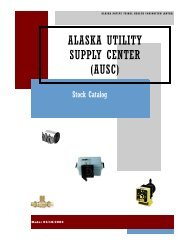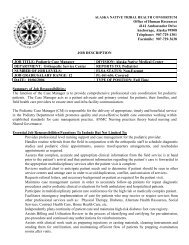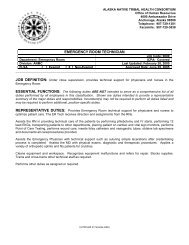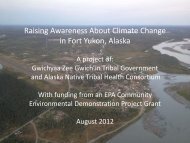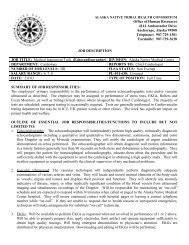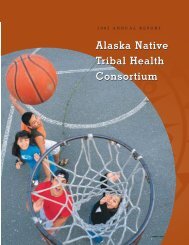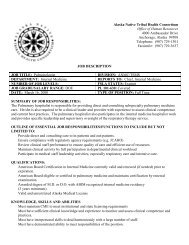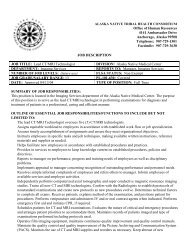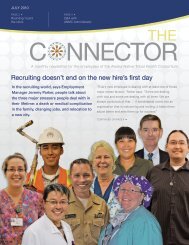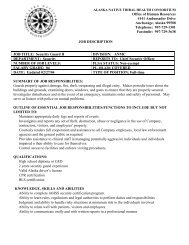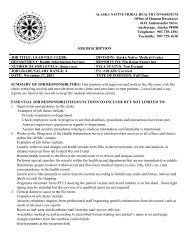Draft Final Climate Change and Health Impacts Point ... - ANTHC
Draft Final Climate Change and Health Impacts Point ... - ANTHC
Draft Final Climate Change and Health Impacts Point ... - ANTHC
Create successful ePaper yourself
Turn your PDF publications into a flip-book with our unique Google optimized e-Paper software.
SUMMARY<br />
In the community of <strong>Point</strong> Hope, subsistence resources, food security, drinking water quality, <strong>and</strong><br />
infrastructure are vulnerable to impacts from climate change. There is limited scientific information to<br />
show relationships between climate effects <strong>and</strong> health outcomes. However, local observations <strong>and</strong><br />
community records indicate that climate change is increasing the risk of injury <strong>and</strong> disease, <strong>and</strong> the risk<br />
of disruption or damage to health infrastructure. Additionally, climate change is placing stress on<br />
municipal resources <strong>and</strong> adding to the cost of water treatment, beach protection, <strong>and</strong> road<br />
maintenance.<br />
Weather archive data from the 1930s show a gradual increase in mean annual temperature <strong>and</strong><br />
precipitation in <strong>Point</strong> Hope. By 2061 to 2070, climate models suggest that average July temperatures will<br />
have increased by approximately 2 o F, <strong>and</strong> December temperatures by 22 o F. Since 1991, average winter<br />
temperatures (January through March) have been below 0 o F, but in 50 years, monthly average<br />
temperatures may not drop below 0 o F, but rather could range between 5 o F <strong>and</strong> 30 o F. Increases in<br />
precipitation are projected for every month except June, as is a drier summer with broad ranging<br />
changes to wildlife, vegetation, <strong>and</strong> water availability.<br />
The rate of shoreline erosion is increasing due to changes in timing of ocean freezing <strong>and</strong> thawing,<br />
delays in the development of shore‐fast ice, <strong>and</strong> increases in the intensity of storms. Flooding has been<br />
prevented through village relocation <strong>and</strong> sea wall construction. Despite these efforts, <strong>Point</strong> Hope<br />
continues to be vulnerable to storm surges <strong>and</strong> ice jams, with both the air strip <strong>and</strong> overl<strong>and</strong> evacuation<br />
route at risk. It is projected that mean sea level could cover much of the <strong>Point</strong> Hope Peninsula within 50<br />
to 100 years.<br />
<strong>Change</strong>s in weather <strong>and</strong> ice conditions are causing delays to subsistence activities, including the timing<br />
of spring whale <strong>and</strong> walrus hunts. Ice conditions have been inadequate in recent years to provide haulout<br />
platforms for walrus, or for hunters to clean bowhead whales. Shore ice has become unstable,<br />
putting hunters at greater risk for injury. In the spring of 2008, shore‐fast ice broke free, casting <strong>Point</strong><br />
Hope whaling crews <strong>and</strong> camps adrift, <strong>and</strong> requiring a helicopter rescue from Barrow. Hunters are also<br />
observing changes in wildlife. Hungry polar bears have begun to frequent <strong>Point</strong> Hope, becoming a<br />
nuisance <strong>and</strong> a public safety concern. Warm summer temperatures are providing opportunities for<br />
invasive species to become established <strong>and</strong> in some instances to interfere with subsistence activities.<br />
Ravens <strong>and</strong> gull populations are increasing <strong>and</strong> interfering with summer fish camp activities. Beaver are<br />
changing the river system <strong>and</strong> increasing the risk of waterborne disease. New fish species such as king<br />
salmon are being harvested, providing a positive new subsistence opportunity.<br />
Two issues were identified that are of special public health concern: food security <strong>and</strong> water quality.<br />
First, the permafrost that cools traditional underground food storage cellars is thawing, <strong>and</strong> there are<br />
currently no community alternatives for storage of whale meat <strong>and</strong> blubber. Secondly, warming is<br />
contributing to changes in 7 Mile Lake, the community drinking water source. Temperature influenced<br />
blooms of organic material have clogged water filters, adversely affecting water treatment.<br />
<strong>Point</strong> Hope would benefit from increased participation in weather, coastal zone <strong>and</strong> wildlife observation<br />
<strong>and</strong> monitoring programs, exp<strong>and</strong>ed collaborations with researchers, <strong>and</strong> increased local capacity for<br />
climate change coordination <strong>and</strong> management. Through such efforts, informed decision‐making can<br />
occur within local government to address vulnerabilities, <strong>and</strong> to adapt to climate change impacts.<br />
2


